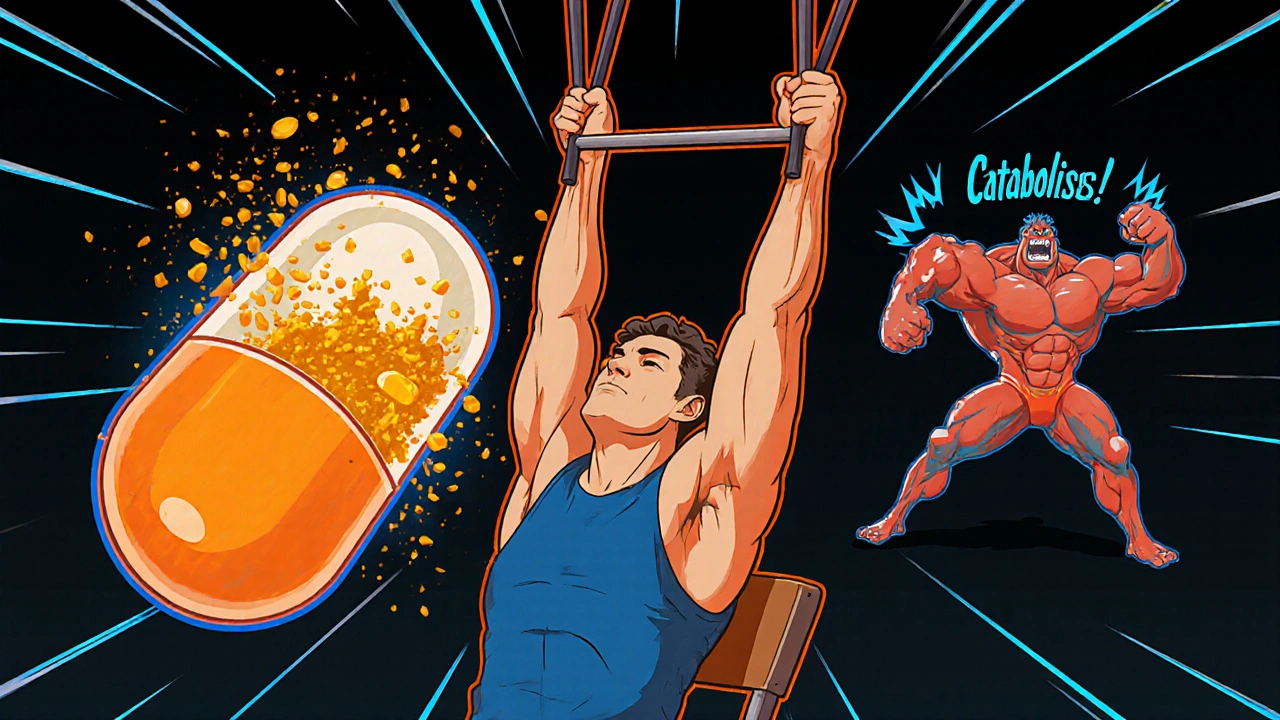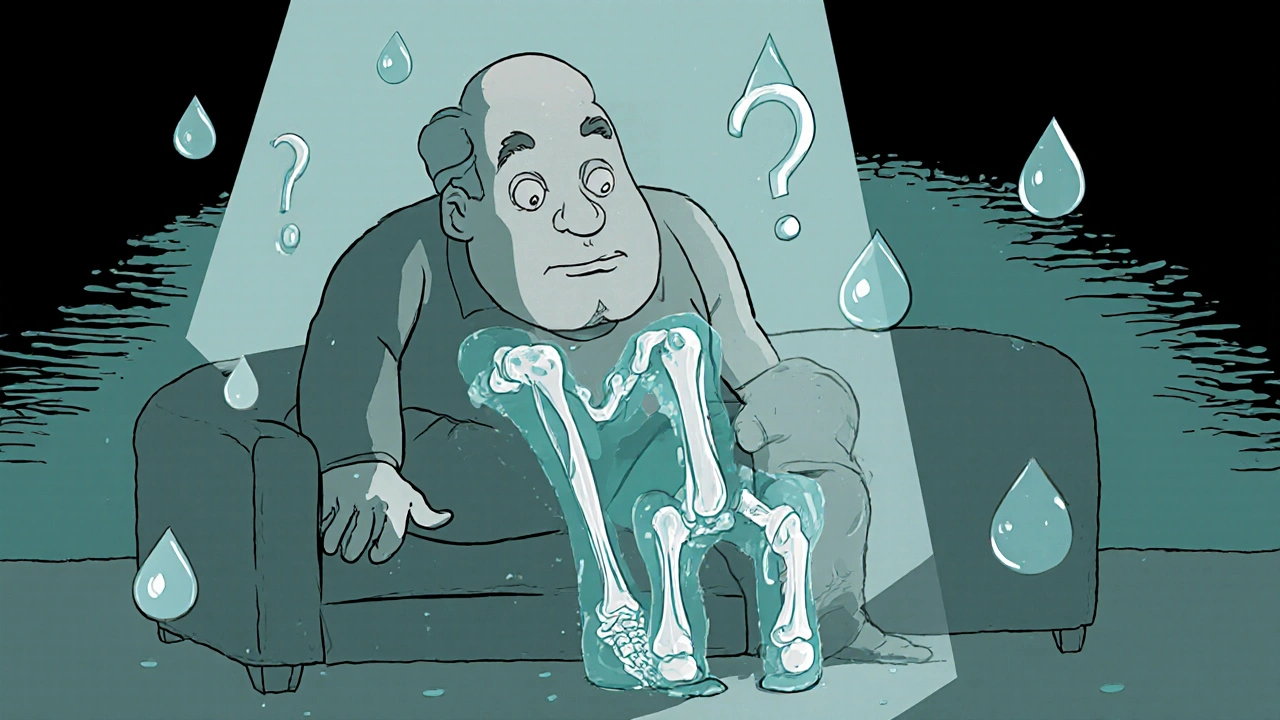Steroid Myopathy Strength Assessment Tool
Strength Assessment
Perform the Timed Chair Rise Test as described in the article to assess your muscle strength. This is the first step in recognizing steroid myopathy.
Recommended Next Steps
What Is Steroid Myopathy?
You’re on steroids to control your asthma, rheumatoid arthritis, or another chronic condition. You’ve been taking them for months. Lately, you’ve noticed you can’t get up from the couch without using your arms. Climbing stairs feels impossible. Lifting your grocery bags? Forget it. And here’s the kicker - it doesn’t hurt. No soreness. No swelling. Just pure, frustrating weakness.
This isn’t just being out of shape. It’s steroid myopathy - a muscle-wasting side effect of long-term corticosteroid use. First noticed in the 1930s, it’s now the most common drug-related muscle disorder in people on chronic steroid therapy. Up to 21% of patients taking daily doses above 10 mg of prednisone for four weeks or more develop it. And because it’s painless and slow, it’s often mistaken for aging, deconditioning, or worsening of the original disease.
Unlike inflammatory muscle diseases, steroid myopathy doesn’t cause elevated creatine kinase levels. Your blood tests look normal. Your EMG comes back clean. But your muscles are shrinking - specifically the fast-twitch type 2b fibers that power standing, climbing, and lifting. These fibers break down due to steroids turning off muscle-building signals and turning up muscle-destroying ones.
How Do You Know It’s Steroid Myopathy - Not Something Else?
Here’s the problem: doctors don’t always check for it. A 2021 study found nearly 40% of cases get misdiagnosed. Why? Because manual muscle tests - the kind where a clinician pushes against your leg or arm - often miss early weakness. You might pass the test but still struggle to stand from a chair without using your hands.
True steroid myopathy has clear signs:
- Painless, symmetric weakness - both sides of your body affected equally
- Proximal muscles first - hips and shoulders weaken before hands or feet
- No muscle pain, swelling, or cramps
- Normal blood work - CK levels stay within 30-170 U/L
- No inflammation on biopsy - unlike polymyositis or dermatomyositis
Compare that to inflammatory myopathies: those cause high CK, abnormal EMG, muscle pain, and often get worse when you stop steroids. Steroid myopathy? It doesn’t get worse when you taper off. In fact, it often improves - slowly - once the dose drops.
High-dose IV steroids in ICU patients can cause acute steroid myopathy within days. These patients may lose strength so fast they need a ventilator. That’s rare, but it’s real. For most people, it’s a quiet, creeping weakness that sneaks up over weeks or months.
Who’s Most at Risk?
If you’re on long-term steroids for any reason, you’re at risk. But some groups are hit harder:
- People on daily prednisone above 10 mg for more than a month
- Those on dexamethasone - it’s more muscle-toxic than prednisone
- Patients with COPD, asthma, lupus, or rheumatoid arthritis
- Older adults - muscle loss accelerates with age
- People who are inactive - disuse makes steroid damage worse
One study found 87% of patients on chronic steroids couldn’t stand from a low chair without pushing off with their arms. That’s not normal aging. That’s muscle wasting. And it’s happening to thousands of people right now - often without anyone noticing.
And here’s the kicker: prednisone is one of the top 35 most prescribed drugs in the U.S. With 17.8 million prescriptions in 2022 alone, steroid myopathy isn’t a rare side effect - it’s a widespread, under-recognized problem.

How Physical Therapy Can Reverse the Damage
Here’s the good news: you can rebuild this muscle. Not overnight. But with the right program, you can regain strength, mobility, and independence.
Traditional advice - rest, avoid exercise - is wrong. Muscle needs stimulation to grow. Even when steroids are breaking it down, resistance training signals your body to rebuild.
The American Physical Therapy Association recommends:
- Start with low intensity - 30% of your one-rep max
- Focus on compound movements: squats, step-ups, seated leg presses, shoulder presses
- Use light weights, higher reps - 10-15 repetitions per set
- Train 2-3 times per week, with rest days in between
- Progress slowly - increase weight by 5-10% every two weeks
A 2020 clinical trial showed patients who followed this approach improved their chair-rise time by 23.7% in just 12 weeks. The control group, who didn’t train, improved only 8.2%. No injuries. No setbacks. Just steady progress.
Why does this work? Resistance training counters the catabolic effects of steroids. It boosts protein synthesis, activates muscle stem cells, and helps rebuild those type 2b fibers. It doesn’t cure the steroid damage - but it fights back.
What Exercises to Do - and What to Avoid
Not all exercise is safe. High-intensity training, heavy lifting, or long endurance sessions can push your muscles past their breaking point.
Do these:
- Chair stands: Sit in a sturdy chair, cross arms over chest, stand up slowly without using hands. Do 3 sets of 8-10 reps.
- Step-ups: Use a low step (4-6 inches). Step up with one foot, then the other. Step down slowly. 10 reps per leg.
- Wall push-ups: Stand arm’s length from a wall. Push body toward wall, then back. Builds shoulder strength safely.
- Seated leg extensions: Use light ankle weights or resistance bands. Extend one leg, hold for 2 seconds, lower slowly.
Avoid these:
- Heavy squats or deadlifts - too much strain on fatigued muscles
- High-intensity interval training (HIIT)
- Long-distance running or cycling - can cause excessive muscle breakdown
- Exercises that cause muscle burning or prolonged soreness
Listen to your body. Mild fatigue is okay. Sharp pain or lasting soreness? Stop. You’re not training to exhaustion - you’re training to rebuild.
How to Track Your Progress
Don’t guess whether you’re getting stronger. Test it.
Try these simple, reliable tests at home once a month:
- Timed Chair Rise Test: Sit in a standard chair (no armrests). Cross arms over chest. Stand up, sit back down. Do 5 reps. Time yourself. Normal is under 10 seconds. Aim to improve by 1-2 seconds each month.
- Arm Raise Test: Stand with arms at your sides. Raise both arms overhead as high as you can. Hold for 5 seconds. Can you do it without shrugging or bending elbows? If not, you’re losing shoulder strength.
- Stair Test: Walk up and down a flight of 10 stairs without holding the railing. If you need to grip the rail, your hip muscles are weak.
Keep a log. Even small improvements matter. A 2-second faster chair rise means you’re less likely to fall. A few more degrees of shoulder motion means you can reach for a glass on a high shelf. These are life-changing gains.

When to Talk to Your Doctor
If you’ve been on steroids for more than a month and notice any of these:
- Difficulty standing from a chair without using your arms
- Needing help to climb stairs
- Struggling to lift objects above shoulder height
- Feeling weaker even though you’re eating well and resting
Don’t assume it’s just part of the disease. Ask your doctor about steroid myopathy. Request a referral to a physiotherapist experienced in neuromuscular conditions.
Also, ask if your steroid dose can be lowered. Many patients can reduce their dose safely with better disease control or alternative treatments. Even a 20% reduction in daily prednisone can slow muscle loss.
And if you’re on dexamethasone - especially for cancer treatment - ask if switching to prednisone is possible. Dexamethasone is significantly more damaging to muscle tissue.
The Future: New Drugs and Better Protocols
Researchers are working on solutions. A new drug called vamorolone - a selective glucocorticoid receptor modulator - shows promise. In trials, it reduced muscle weakness by 40% compared to prednisone at the same anti-inflammatory dose. It’s not available everywhere yet, but it’s a sign that the medical world is finally paying attention.
Also, the International Myopathy Guidelines Consortium is finalizing the first-ever standardized physical therapy protocol for steroid myopathy. That means more therapists will know exactly how to help you - no more guessing.
For now, the best tools you have are awareness, movement, and persistence. You’re not powerless. Your muscles may be under attack, but they’re not defeated.
Frequently Asked Questions
Can steroid myopathy be reversed completely?
Yes, in most cases. Once steroid doses are reduced or stopped, muscle strength gradually returns - especially with consistent, moderate resistance training. Recovery can take 3 to 12 months, depending on how long you were on steroids and how much muscle was lost. Some people regain full strength; others reach a new baseline that’s slightly weaker than before - but still functional and independent.
Does steroid myopathy cause muscle pain?
No. That’s one of its defining features. Unlike inflammatory muscle diseases, steroid myopathy is painless. You won’t feel soreness, cramps, or tenderness. The weakness is silent, which is why it’s often missed. If you have pain along with weakness, it’s likely another condition - like polymyositis or nerve damage - and needs different testing.
Can I still exercise if I’m on high-dose steroids?
Yes - but carefully. Low-to-moderate resistance training is safe and beneficial, even on high doses. Avoid heavy lifting, long cardio sessions, or anything that leaves you exhausted. Start with bodyweight exercises like chair stands and wall push-ups. Progress slowly. Always check with your physiotherapist before adding resistance. The goal is to stimulate, not stress, your muscles.
Why don’t blood tests show muscle damage in steroid myopathy?
Because steroid myopathy doesn’t involve muscle inflammation or cell rupture. Inflammatory muscle diseases break open muscle cells, spilling enzymes like creatine kinase (CK) into the blood. Steroid myopathy works differently - it’s a slow, controlled breakdown of muscle proteins without cell rupture. So your CK stays normal, even though your muscles are shrinking. That’s why blood tests can’t diagnose it - you need functional tests and physical assessment.
How long does it take to see results from physical therapy?
Most people notice small improvements in 4-6 weeks - like being able to stand from a chair without using hands. Significant gains - like climbing stairs without railings - usually take 3-6 months. Progress is steady but slow. Consistency matters more than intensity. Skipping sessions delays results. Even 20 minutes, three times a week, makes a difference.
